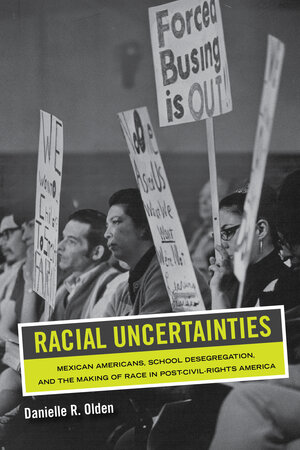The Book
Racial Uncertainties: Mexican Americans, School Desegregation, and the Making of Race in Post-Civil Rights America
The Author(s)
Danielle R. Olden

Danielle R. Olden’s Racial Uncertainties: Mexican Americans, School Desegregation, and the Making of Race in Post-Civil Rights America examines the Supreme Court case Keyes v. School District No. 1, Denver as a case study of the way in which American binary conceptions of race affected the process of identity formation among Mexican Americans. Olden argues that during the 1970s Mexican Americans were caught between a recognition of disparate treatment and a desire to reap the benefits of white privilege, which complicated their position inside post-civil rights racial politics.
By analyzing the political position of different Mexican American social, cultural, and community groups regarding the school integration plan that stemmed from the Keyes decision, Olden explains why context matters for understanding how race is constructed. The book is at its best when it discusses the contradictory rhetorical strategies that various Mexican American groups used to secure a privileged space in the Denver Public School system. For instance, by simultaneously aligning themselves with whiteness and minority status, certain privileged sectors of the Mexican American community sought to distance themselves from the integration calls made by the African American community in Denver to secure their privileged position. Contrastingly, other sectors of the Mexican American community understood that the only currently available path towards equality was to lose the privileges that had been awarded to them as court-recognized white citizens to secure more linguistically and culturally appropriate education.
To me, Olden’s most interesting discussion is her explanation of how the Chicano/a rights group, Crusade for Justice, evolved in its understanding of race and ethnicity, ultimately landing at an ambiguous point of simultaneously aligning with and distancing from the African American experience, which is very illustrative of the Latinx experience in the United States. This group understood the inequities imbedded in the U.S. system but it also took a more pragmatic approach of seeking to secure resources for their own community to advance their agenda. That is, rather than creating broad racial coalitions where priorities, like bilingual education, needed to be compromised, they chose to adopt a protectionist position.
Overall, Racial Uncertainties explains how racial and ethnic identities are both time and space specific but also how the law works to cement our understanding of identity and eliminate the possibility for fluidity. Additionally, the book helps show how Mexican American’s position as simultaneously white and non-white served as a powerful rhetorical tool for white groups to ascertain that, since race could not be defined with certainty, then it could not be used to assign or deny privilege, and thus securing a conception of the need for the law to be “colorblind.”
About the Reviewer
Naida García-Crespo is an independent researcher with a PhD in English from the University of Illinois in Urbana Champaign. Her work has appeared in Film History, Early Popular Visual Culture, and CENTRO Journal, among other journals. She is the author of Early Puerto Rican Cinema and Nation Building (1897-1940): National Sentiments, Transnational Realities (Bucknell University Press, 2019).

0